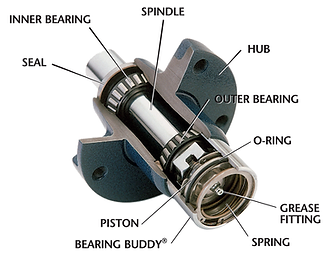How Genuine Bearing Buddy® Works
The axle hub is filled with grease until the grease forces the Bearing Buddy® piston outward about 1/8 inch. Because the piston is spring loaded, the piston exerts a slight (3 PSI) pressure against the grease, which maintains a slight pressure between the inside of the hub and the outside environment. When the hub is submerged, water cannot enter the hub because of this pressure. An automatic pressure relief feature prevents over-filling and over pressurization. See Bearing Buddy diagram: Without this feature, the inner seal will be damaged.

Grease can be added to the hub through an easily accessible grease fitting located in the center of the piston. Lubricant level (and pressure) can be checked quickly by pressing on the edge of the moveable piston. If you can rock or move the piston, the hub is properly filled. In addition to packing the bearings in the traditional manner, it's best to get as much grease as possible inside the hub cavity between the bearings and then, while the Bearing Buddy® is off, fill it with grease as well from the backside. The air pockets inside the hub cavity and Bearing Buddy® will work their way out past the piston (or blue ring) on the Bearing Buddy®.
You should see the piston extend out or the blue ring past the front of the Bearing Buddy® when it's properly filled. However, as air escapes the piston (or blue ring) is going to collapse inward. This is normal. After driving several miles, check the piston (or blue ring) to see if it has moved inward. If it has, add a little more grease to get the piston to move outward or the blue ring to move about 1/8" past the front of the Bearing Buddy®. You may have to do this a couple of times before all the air pockets are gone and the entire hub cavity is filled with grease.
Bearing Buddy® will last the life of your trailer. The outer barrel is made of steel and is triple chrome plated. Internal Bearing Buddy® parts are made of stainless steel. Bearing Buddy® is also available with a stainless steel barrel for maximum corrosion protection.






